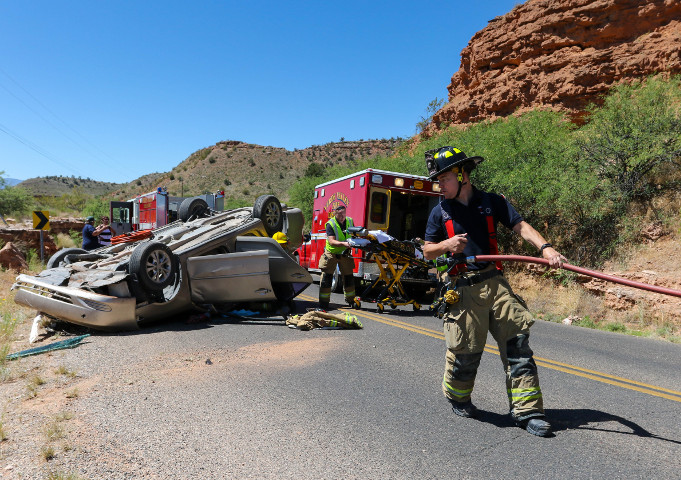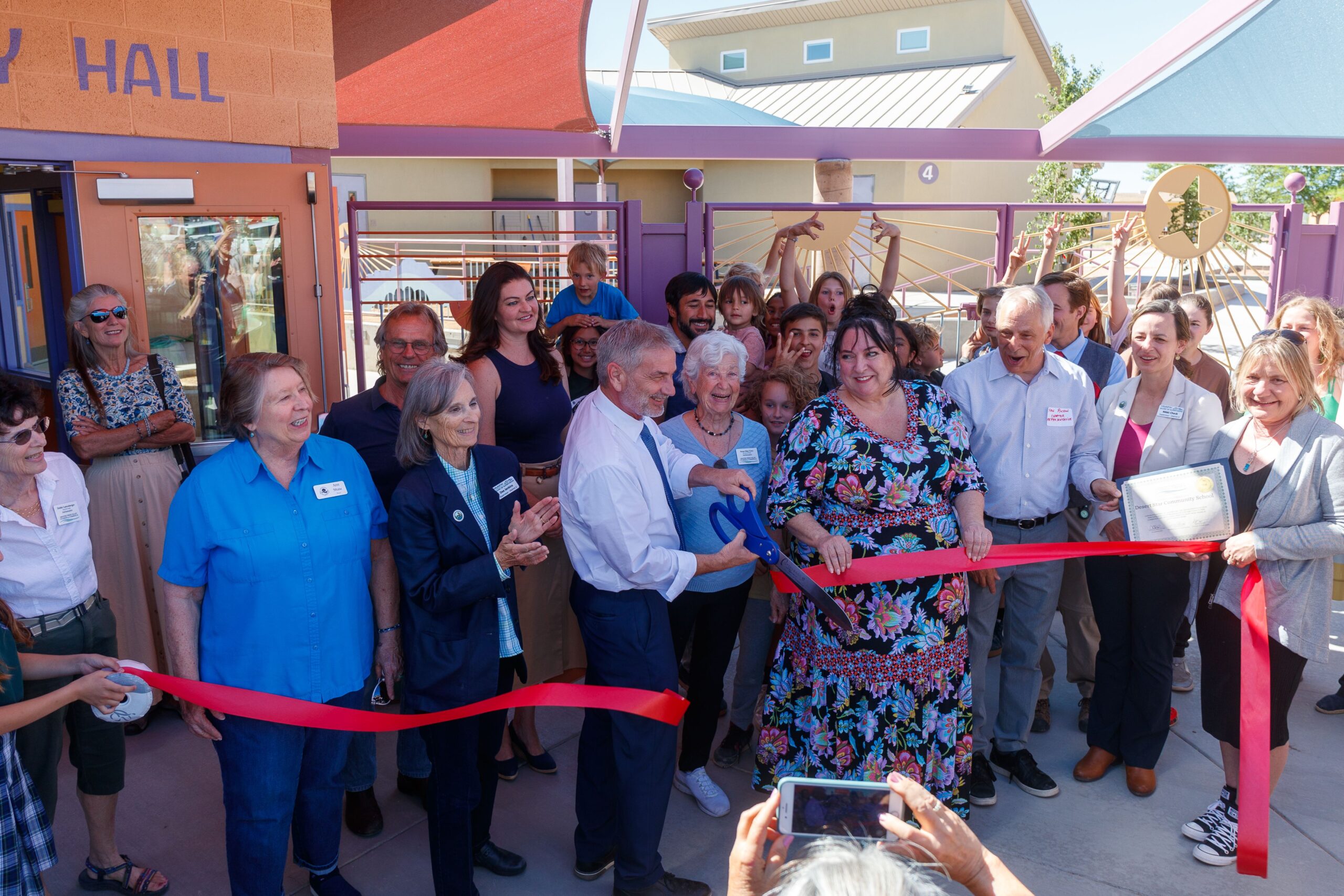Ever wanted to know what firefighters do besides help civilians and putting out fires? I decided to spend the day with the men of Verde Valley Fire District Station 31 to know what really goes on when they aren’t out risking their lives for citizens.
Tuesday morning, I arrived at the station around 7 a.m. to meet Capt. Dustin Chambliss. He introduced me to the men he was working with on shift B. He left me with Joseph Loehr, who gave me the grand tour of the station showing me the living quarters, workout room and bedrooms.
During my tour the men inspected the trucks and equipment within each vehicle to make sure everything was functional and the medical equipment was ready to be used in the situation it would be needed in. While I watched, photographed and talked to the men, Chambliss gave me the pager they use whenever dispatch calls them in for a mission and told me I would be riding with him and Bryan Heisinger in the firetruck for the day. The device would set off an alarm, vibrate and then I could hear what information was being told to the everyone who had one of these and a radio.
Before it was even 8 a.m. we were already rushing to the fire truck to a home that may have a carbon monoxide problem. As we arrived on scene, Chambliss and Heisinger went up to the resident that made the call complaining about a weird smell in the house and the side effects she had been having recently while at home. They weren’t able to find any carbon monoxide as they searched the house with their scanners that would detect any increased levels of it. As the resident apologized for the inconvenience of the call, both of the firemen reassured her that it was fine and they were glad she made the call because that was their job to protect the public and it’s better to be safe than sorry.
We departed from our first call and hopped back into the firetruck to go back to the station. As we rode down the road, Heisinger and Chambliss caught up with each other and what they did on their days off with their family before we arrived back at the station for them to resume busy work with papers and finishing the inspections on the trucks.
As Chambliss went back to his office, I spent time with Heisinger as he inspected the truck and all of the equipment within it. He showed me the oxygen tanks, how much they weighed and the amount of time a firefighter would have before he or she ran out of oxygen when the situation required its use. I was surprised with how much equipment is stored within one firetruck. The items ranged from medical equipment to chain saws and the jaws of life.
He finished his work and we went inside to get coffee and before we knew it the sound of the pager went off for a resident that had fallen over and couldn’t get up. We were back in the truck racing down the road with the EMS truck behind us as well in case of the need of a quick extraction to the hospital.
When we arrived on scene, the men brought out the stretcher and went inside to the caller’s house. Luckily, there was nothing severe to his fall and the need of an extraction was not necessary. Again we loaded back up into the truck and headed to the station.
Three calls before lunch and it was looking like the “Ride Along Curse” that I heard so much of was not affecting me today and the other firemen were glad too because they didn’t just want photos of them sitting around and washing trucks.
It turned out I was working the same day as the meeting of the district’s Governing Board and where Spencer Young was recognized for his promotion to engineer. The meeting consisted of Chief Nazih Hazime telling the board the finances of the district and how they were looking for the year. Then with a sudden vibration from my pager on my belt I was already running with the other guys on duty back to the trucks for one of the most exciting calls of the day.
We hopped into the truck, Heisinger cut on the siren and Chambliss turned around and said, “We’ve got a flipped over vehicle, Hunt, you may need to stay back until the scene is cleared because we were told that it’s possibly smoking and the victim is pinned inside of the car.”
I could feel the adrenaline pumping through me and we raced down the highway dodging traffic as fast as Heisinger could drive the truck. We arrived at the scene on Loy Road where I could see as we pulled up a car that was turned over with the other fire district station already on scene helping the victim.
I jumped out of the truck with them and began watching Heisinger pull the fire hose toward the car to spray down in case of a fire. I could smell gasoline leaking from the vehicle and the men working quickly to get the victim out of the car and onto the stretcher for extraction to a hospital.
I photographed and watched in astonishment how quickly and effectively these men were able to pull the victim out. Constantly communicating with each other and the victim to make sure they were OK and reassuring the victim they were going to take care of the situation to the best of their ability.
And all too soon I was greeted with a familiar scenario with a tap on the shoulder and police officer telling me to get back. With some experience photographing protests and riots in Baton Rouge, La., I knew how this was going to play out. I tried to argue that I was with firemen of Station 31, the highway patrol proceeded to ask the wrong firefighter that didn’t know who I was and told him I wasn’t with them.
I was then ushered back behind the firetruck and as much as I wanted to say something, it probably wouldn’t be in the best interest to be arrested today. A few moments later the same highway patrolman came back apologizing for making me go back and we laughed about the misunderstanding and I was back with the crew watching them work. The victim was already gone in an EMS truck and the men of Station 31 let the other responders handle the rest.
After lunch, Chambliss and Heisinger took me to the dispatch center in Cottonwood, where they showed me the behind-the-scenes of how 911 calls work and the people there that are on the other end of the line. I met the crew of the Cottonwood Fire Department that were on duty at the time after showing me the dispatch center.
The men all greeted each other with smiles and handshakes, asking each other how things were going with family and work. Although they were from different stations there was still a sense of brotherhood among them.
We hung out there for a bit and we were back on the road to the station and the end of my shift as a ride along. What I learned being with these men is that they do love their jobs and community. Every day isn’t putting out fires and saving lives for them. Some days can be a simple call to make sure a house is safe from a leak of gas or to help someone who has fallen.
These men helped me gain a new perspective of what it was really like to be a firefighter for a day and how they function as a team.



